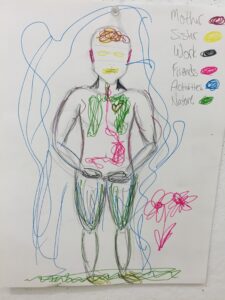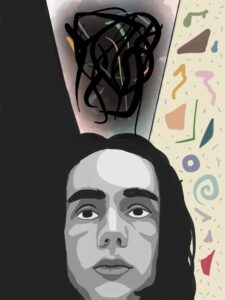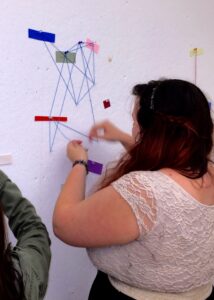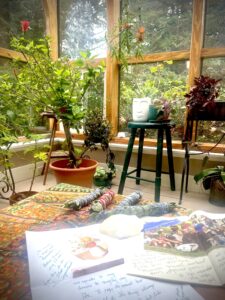Want more play and joy in life? Want to tap into your inner knowing or intuition? Do you have some emotions to connect with and release? Expressive arts might be a great mindfulness practice for you.
As a former middle school teacher and a mindfulness and creative writing instructor at Clark University, I have used expressive arts in my classes and in my own personal practices for decades.
Now, I look to bring these liberating exercises to adults outside of a school setting. In a world filled with constant noise and chaos, finding time for and a way to express ourselves authentically and tap into our inner creativity is more important than ever. One powerful avenue for self-expression and personal growth is through the world of expressive arts.
In this post, let’s explore what expressive arts are, the types of activities included, and the myriad purposes and benefits of engaging in these transformative practices. Grab my free guide if you want to try some exercises for yourself or explore with your family and friends this holiday season.
What Are Expressive Arts?
Expressive arts encompass a wide range of creative activities that encourage individuals to express themselves through various art forms. Expressive arts help us get in touch with and embody emotions and feelings, to get them out in front of us where we can see them and address them. While making art—whether it be a little poem, collage, or drawing—the goal is the process, not the product. It is not an art class, but a mindfulness activity in which we are being with what is in the present moment.
Expressive arts often take us to a place beyond words, beyond the place where words alone often fail us or block us. Unlike with traditional art, the focus in expressive or therapeutic arts is not on creating a masterpiece; rather, it’s about the process of creating and the emotions, thoughts, and experiences that unfold during that process.
Types of Activities in Expressive Arts:
- Visual Arts: Drawing, painting, sculpting, collage-making, and mixed media art are common forms of visual expression in the world of expressive arts. Participants explore their inner world through color, shape, and texture.
- Music and Sound: Music therapy is a powerful expressive arts tool. Playing instruments, singing, or simply listening to music or a singing bowl can evoke powerful emotions and provide a means of communication when words fall short.
- Dance and Movement: Dance and movement therapy are a physical manifestation of emotional expression. Through dance, individuals can explore their body’s sensations and movements as well as connect with their emotions in a non-verbal way. I love Yoga Dance!
- Writing: Journaling, poetry, storytelling, and creative writing offer a means of expressing thoughts and feelings. Writing can be a cathartic outlet, a tool for self-reflection, and a way to share one’s narrative with the world.
- Drama and Theater: Theater exercises, role-playing, and improvisational activities allow participants to explore different personas and scenarios, fostering self-awareness and empathy.
- Photography: Capturing images allows individuals to see the world through their own unique lens. It’s a visual storytelling tool that can be deeply personal and emotional.
The Purpose and Benefits of Expressive Arts:
- Self-Exploration: Expressive arts provide a mindful, safe, and non-judgmental space for individuals to explore their inner world, uncovering hidden emotions, fears, and desires.
- Emotional Release: Engaging in creative expression can be cathartic, enabling the release of pent-up emotions and providing relief from stress and anxiety.
- Self-Reflection: Expressive arts activities encourage individuals to reflect on their experiences, gaining a deeper understanding of themselves, their actions, motivations, emotions, and relationships.
- Enhanced Communication: For those who find it challenging to express themselves verbally, expressive arts offer an alternative means of communication and connection.
- Healing and Therapy: Art therapy and expressive arts can be therapeutic tools for individuals dealing with trauma, grief, mental or physical health challenges.
- Boosted Creativity: Engaging in expressive arts activities can enhance creativity and problem-solving skills in various areas of life.
- Connection with Others: Participating in group expressive arts activities fosters a sense of community and shared experience, promoting social bonds and support.
- Self-Confidence: As individuals discover their creative abilities and come to know themselves better, their self-confidence and self-esteem often grow.
Amidst the constant striving and hustle of daily life, expressive arts offer a valuable space to pause, connect with ourselves, and explore the depths of our emotions and creativity. Whether you’re an experienced artist or a beginner, engaging in expressive arts can be a transformative and liberating experience. So, take a breath and then a leap onto the page and into the world of expressive arts to discover the power of creative freedom for yourself.




